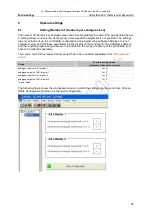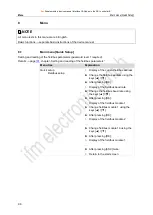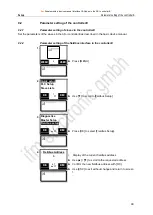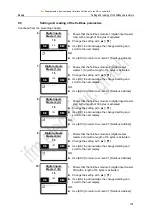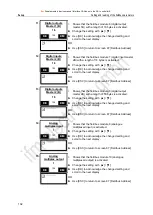
ifm
Supplementary device manual Interface CANopen in the AS-i controllerE
Terms, abbreviations
106
10
Terms, abbreviations
A/B slave
Slave with an A or B being appended to its address number and which may
therefore be present twice on the
master.
Address
This is the "name" of the bus participant. All participants need a unique address
so that the signals can be exchanged without problem.
AS-i
AS-i =
A
ctuator
S
ensor
I
nterface
Bus system for the first binary field level.
Baud
Baud, abbrev.: Bd = unit of measurement of the speed of data transmission. Do
not confuse baud with "bits per second" (bps, bits/s). Baud indicates the number
of changes of state (steps, cycles) per second over a transmission length. But it
is not defined how many bits per step are transmitted. The name baud can be
traced back to the French inventor J. M. Baudot whose code was used for telex
machines.
1 MBd = 1024 x 1024 Bd = 1 048 576 Bd
Operating system
Basic program in the device, establishes the connection between the hardware
of the device and the user software.
Bus
Serial data transmission of several participants on the same cable.
CAN
CAN =
C
ontroller
A
rea
N
etwork
CAN is a priority-based fieldbus system for large data volumes. It is available in
different variants, e.g. CANopen , CAN in Automation (CiA) or
CANopen. CAN
can be used e.g. as a supplier for AS-i over larger distances. Corresponding
gateways are available.
CoDeSys
CoDeSys for Automation Alliance associates companies of the automation
industry whose hardware devices are all programmed with the widely used IEC
61131-3 development tool CoDeSys®.
CoDeSys® a registered trademark of 3S
– Smart Software Solutions GmbH,
Germany.
ControllerE
Master in the AS-i bus system of the generation E
CANopen
Fieldbus system for larger data volumes based on
CAN technology, requires
special cables, complex connection technology. Can be used e.g. as a supplier
for AS-i over longer distances. Corresponding
gateways are available.
DHCP
DHCP =
D
ynamic
H
ost
C
onfiguration
P
rotocol = protocol for the dynamic
configuration by the
host
DHCP is a protocol that provides dynamic configuration of IP addresses and
associated information. The protocol supports use of IP addresses which are
only available in limited number by a centralised management of the address
assignment.
The participant logs on to a server with this service when it is switched on in a
network for the first time. The server assigns a local free
IP address to the
participant.
EMC
EMC =
E
lectro
M
agnetic
C
ompatibility
According to the EC directive (89/336 EEC) regarding electromagnetic
compatibility (short EMC Directive) there are requirements regarding the
capacity of electrical and electronic equipment, installations, systems or
components to operate satisfactorily in the given electromagnetic environment.
The devices must not disturb their environment and must not be influenced by
external electromagnetic disturbances.


